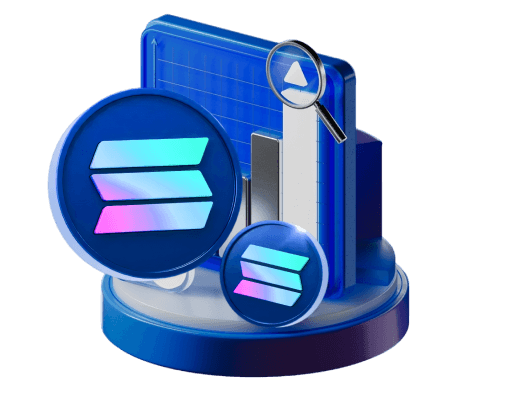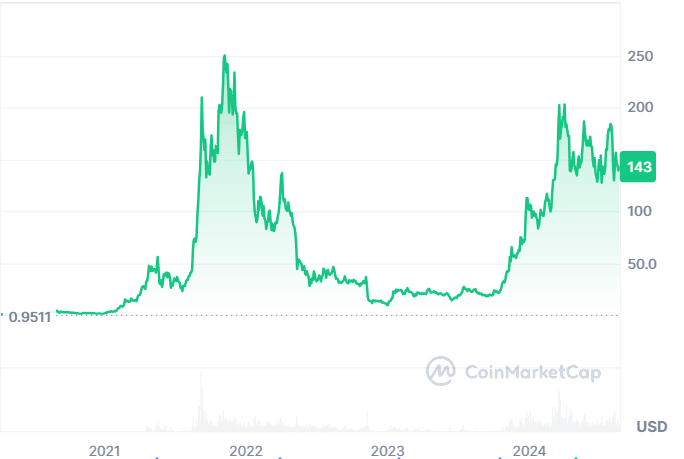Solana Kursverlauf:
Die Hochs und Tiefs verstehen

Zeit zum Lesen: 6 min
An Introduction to Solana and its Price History
The cryptocurrency market is known for its volatility, with asset prices fluctuating based on a wide range of factors. Among the most notable projects is Solana, a high-performance blockchain that has gained significant attention for its speed and low transaction costs. Understanding Solana's price history offers valuable insight into its value proposition and future potential.
Solana emerged as a major contender in the digital currency space by addressing the scalability challenges that plagued other blockchains. Its unique Proof-of-History (PoH) consensus mechanism allows it to process transactions faster and more affordably. The Solana Foundation, the organization guiding the project, has been instrumental in fostering adoption and development, ensuring the blockchain remains competitive in a rapidly evolving market.
Key Milestones in Solana's Valuation
Solana's price history is marked by several significant milestones. Launched in March 2020, the network quickly gained traction as developers recognized its potential for decentralized applications (dApps) and smart contracts. The blockchain's ability to handle thousands of transactions per second made it an attractive option for high-throughput solutions. The value of its native token, SOL, surged during the 2021 bull market, reaching an all-time high of nearly $260 in November of that year. Conversely, its all-time low was recorded shortly after its launch, when its value was just a fraction of a dollar. Despite these fluctuations, Solana has consistently maintained a large market capitalization, reflecting its importance in the broader digital asset ecosystem.

Staking and Current Market Position
Staking on the Solana network has played a critical role in its value dynamics. Solana uses a combination of Proof-of-Stake (PoS) and its signature Proof-of-History (PoH) to secure the network. This hybrid approach has made staking on Solana particularly appealing, as it offers competitive rewards while contributing to the overall security and efficiency of the blockchain. As more users participate in staking, the demand for SOL can increase, positively impacting its value.
Today, Solana holds a strong position in the digital asset market. With a market capitalization that consistently places it among the top cryptocurrencies, it remains a preferred choice for both developers and investors. While its monetary value has experienced fluctuations, its robust technology and active community have helped maintain its relevance and utility.
How Solana Compares to Other Blockchains
Solana's innovative technology truly sets it apart from other blockchains. Its hybrid consensus mechanism, combining Proof-of-History with Proof-of-Stake, enables it to process transactions with exceptional speed and efficiency, making it one of the fastest networks available. This technological advantage has made Solana a preferred platform for developers building scalable dApps, particularly in the realms of decentralized finance (DeFi) and non-fungible tokens (NFTs).
Compared to competitors like Ethereum, Solana offers significantly higher throughput and lower transaction fees. This has positioned it as a strong contender for projects requiring a fast and cost-effective infrastructure. The active support from the Solana Foundation has also fostered a vibrant developer community, further solidifying its standing as a leading blockchain platform.
Technological Advances and Future Outlook
Solana's technological advancements are the primary drivers of its value. The efficiency of the network has made its native token, SOL, an attractive asset for both retail and institutional investors. The growing use of Solana for DeFi, NFTs, and other applications has fueled demand for SOL, cementing its status as a valuable digital asset.
The future of Solana appears promising. Solana Labs and the Solana Foundation continue to invest in the network's development, with plans to introduce new features and improvements. As more projects choose to build on its platform, Solana has the potential to become an even more dominant force in the crypto economy. While its exact price trajectory is difficult to predict, the blockchain's strong fundamentals suggest it will continue to play a key role in the digital asset industry.
Understanding Solana's Market Volatility
Like the broader cryptocurrency market, Solana is no stranger to volatility. Several factors contribute to its price fluctuations, including general market trends, technological developments, and regulatory news. As a leading blockchain, it is closely watched by investors, meaning even minor developments can have a significant impact on its price. In bull markets, Solana's price has often outpaced other cryptocurrencies, while bear markets have led to sharp declines. The Solana Foundation works to mitigate these effects by continuously improving the blockchain and supporting its ecosystem, but the inherent volatility of the digital asset market means price swings are unavoidable.
Conclusion
In summary, Solana has firmly established itself as a leading cryptocurrency, delivering significant value through its high-performance blockchain. While subject to market volatility, its technological advantages and growing ecosystem point toward a promising future. As the digital economy evolves, Solana is well-positioned to remain a cornerstone of the industry and potentially reach new heights.
Häufig Gestellte Fragen
Ähnliche Leitfäden
Solana Preisvorhersage:
Detaillierte SOL-Preisprognose
Sept. 21, 2025
Solana (SOL):
Revolutionierung der Blockchain-Technologie
Sept. 26, 2025
Solflare und Solana:
Eine perfekte Kombination für nahtlosen Wallet-Zugang
Sept. 23, 2025

An Introduction to Solana and its Price History
The cryptocurrency market is known for its volatility, with asset prices fluctuating based on a wide range of factors. Among the most notable projects is Solana, a high-performance blockchain that has gained significant attention for its speed and low transaction costs. Understanding Solana's price history offers valuable insight into its value proposition and future potential.
Solana emerged as a major contender in the digital currency space by addressing the scalability challenges that plagued other blockchains. Its unique Proof-of-History (PoH) consensus mechanism allows it to process transactions faster and more affordably. The Solana Foundation, the organization guiding the project, has been instrumental in fostering adoption and development, ensuring the blockchain remains competitive in a rapidly evolving market.
Key Milestones in Solana's Valuation
Solana's price history is marked by several significant milestones. Launched in March 2020, the network quickly gained traction as developers recognized its potential for decentralized applications (dApps) and smart contracts. The blockchain's ability to handle thousands of transactions per second made it an attractive option for high-throughput solutions. The value of its native token, SOL, surged during the 2021 bull market, reaching an all-time high of nearly $260 in November of that year. Conversely, its all-time low was recorded shortly after its launch, when its value was just a fraction of a dollar. Despite these fluctuations, Solana has consistently maintained a large market capitalization, reflecting its importance in the broader digital asset ecosystem.

Staking and Current Market Position
Staking on the Solana network has played a critical role in its value dynamics. Solana uses a combination of Proof-of-Stake (PoS) and its signature Proof-of-History (PoH) to secure the network. This hybrid approach has made staking on Solana particularly appealing, as it offers competitive rewards while contributing to the overall security and efficiency of the blockchain. As more users participate in staking, the demand for SOL can increase, positively impacting its value.
Today, Solana holds a strong position in the digital asset market. With a market capitalization that consistently places it among the top cryptocurrencies, it remains a preferred choice for both developers and investors. While its monetary value has experienced fluctuations, its robust technology and active community have helped maintain its relevance and utility.
How Solana Compares to Other Blockchains
Solana's innovative technology truly sets it apart from other blockchains. Its hybrid consensus mechanism, combining Proof-of-History with Proof-of-Stake, enables it to process transactions with exceptional speed and efficiency, making it one of the fastest networks available. This technological advantage has made Solana a preferred platform for developers building scalable dApps, particularly in the realms of decentralized finance (DeFi) and non-fungible tokens (NFTs).
Compared to competitors like Ethereum, Solana offers significantly higher throughput and lower transaction fees. This has positioned it as a strong contender for projects requiring a fast and cost-effective infrastructure. The active support from the Solana Foundation has also fostered a vibrant developer community, further solidifying its standing as a leading blockchain platform.
Technological Advances and Future Outlook
Solana's technological advancements are the primary drivers of its value. The efficiency of the network has made its native token, SOL, an attractive asset for both retail and institutional investors. The growing use of Solana for DeFi, NFTs, and other applications has fueled demand for SOL, cementing its status as a valuable digital asset.
The future of Solana appears promising. Solana Labs and the Solana Foundation continue to invest in the network's development, with plans to introduce new features and improvements. As more projects choose to build on its platform, Solana has the potential to become an even more dominant force in the crypto economy. While its exact price trajectory is difficult to predict, the blockchain's strong fundamentals suggest it will continue to play a key role in the digital asset industry.
Understanding Solana's Market Volatility
Like the broader cryptocurrency market, Solana is no stranger to volatility. Several factors contribute to its price fluctuations, including general market trends, technological developments, and regulatory news. As a leading blockchain, it is closely watched by investors, meaning even minor developments can have a significant impact on its price. In bull markets, Solana's price has often outpaced other cryptocurrencies, while bear markets have led to sharp declines. The Solana Foundation works to mitigate these effects by continuously improving the blockchain and supporting its ecosystem, but the inherent volatility of the digital asset market means price swings are unavoidable.
Conclusion
In summary, Solana has firmly established itself as a leading cryptocurrency, delivering significant value through its high-performance blockchain. While subject to market volatility, its technological advantages and growing ecosystem point toward a promising future. As the digital economy evolves, Solana is well-positioned to remain a cornerstone of the industry and potentially reach new heights.
